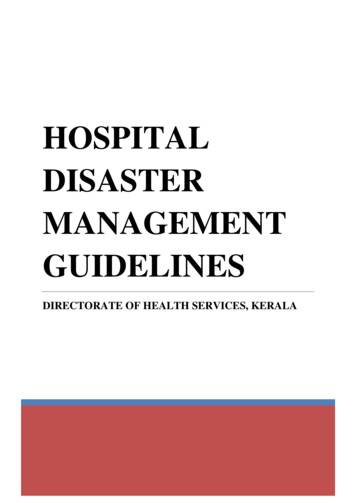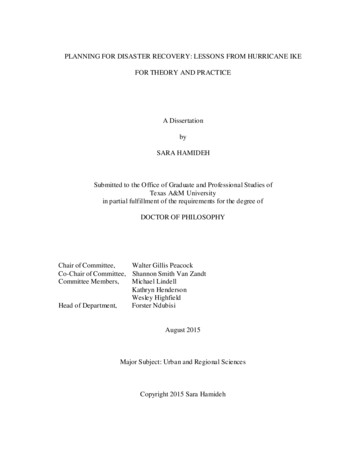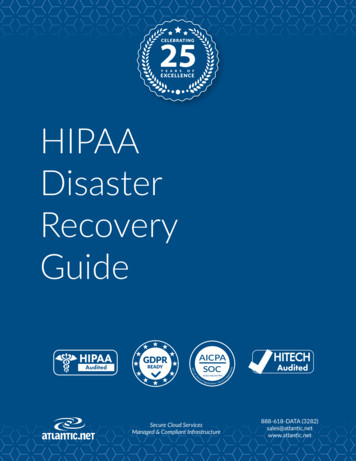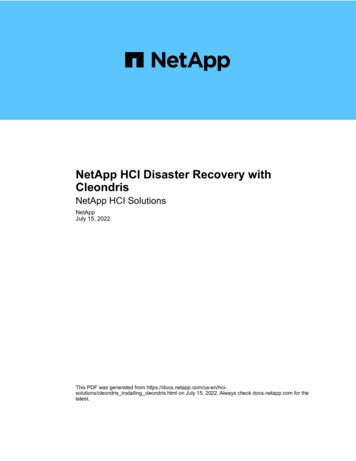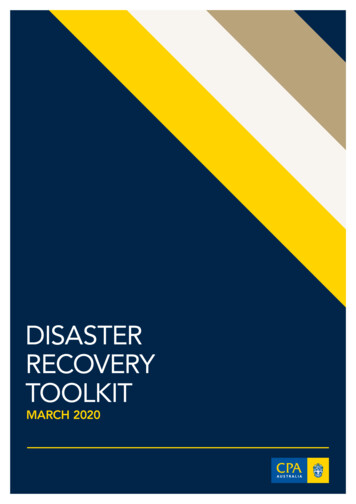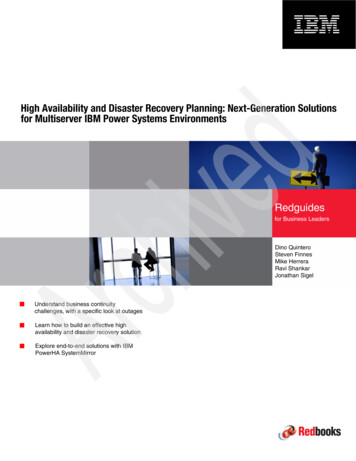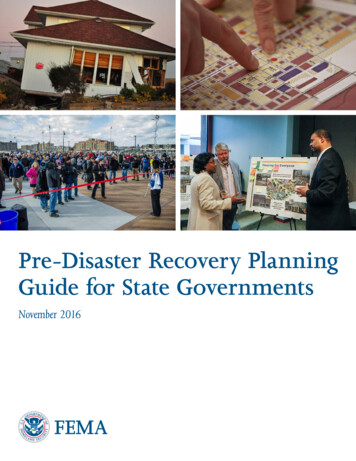
Transcription
Pre-Disaster Recovery PlanningGuide for State GovernmentsNovember 2016
FEMA Publication Number: 104-008-3
Pre-Disaster Recovery Planning Guide for State GovernmentsTABLE OF CONTENTSACRONYMS . ivI. INTRODUCTION .1Purpose of this Guide .3Audience .3Presidential Policy Directive 8.5National Preparedness Goal.5II. NATIONAL CONTEXT FOR PRE-DISASTER RECOVERY PLANNING .5National Disaster Recovery Framework.7National Mitigation Framework.8Recovery Activities are Locally Driven.9Disaster Recovery Planning is Broad and Inclusive.9Recovery Planning is Holistic and Long Term.9III. KEY CONCEPTS FOR STATE-LEVEL RECOVERY PLANNING .9State-Level Planning is Necessary for Disasters of All Sizes. 10Recovery Planning is Closely Aligned with Hazard Mitigation and Building Resilience. 10IV. PRE-DISASTER RECOVERY PLANNING AND RESPONSE PLANNING LINKAGES . 13V. PRE-DISASTER AND POST-DISASTER RECOVERY PLANNING LINKAGES . 15VI. THE STATE PRE-DISASTER RECOVERY PLAN DEVELOPMENT PROCESS . 17A. Step 1 – Form a Collaborative Planning Team . 18B. Step 2 – Understand the Situation. 21C. Step 3 – Determine Goals and Objectives .25D. Step 4 – Plan Development .27E. Step 5 – Plan Preparation, Review, and Approval.52F. Step 6 – Plan Implementation and Maintenance .53Page i
Pre-Disaster Recovery Planning Guide for State GovernmentsVII. CONCLUSION . 57APPENDIX A: REFERENCES . 59APPENDIX B: FACTORS FOR A SUCCESSFUL RECOVERY . 61Short Term (days):.65Intermediate Term (weeks-months):.65APPENDIX C: SUCCESSFUL RECOVERY OUTCOMES .65Long Term (months-years):.66The Commonwealth of Pennsylvania and Disaster Recovery and Preparedness .69APPENDIX D: STATE RECOVERY COORDINATION AND MANAGEMENT CASE STUDIES .69State of Mississippi's Recovery Management Following Katrina. 71State of New York's Recovery Coordination and Management Following Hurricane Sandy . 73State of Louisiana's Recovery Management Following Hurricanes Katrina and Rita. 76State of Colorado's Recovery Management Following Flooding and Landslides in 2013.79APPENDIX E: PLANNING CHECKLIST .83APPENDIX F: TERMS AND DEFINITIONS . 95Page ii
Pre-Disaster Recovery Planning Guide for State GovernmentsFiguresFigure 1 Relationships between Different Levels of Government.7Figure 2 Types of Planning Activities. 15Figure 3 Comprehensive Preparedness Guide Planning Steps. 17Figure 4 The Cyclical Nature of Planning.22Figure 5 Disaster Types. 24Figure 6 Components of a Pre-Disaster Recovery Plan.53Figure 7 The Recovery Continuum. 67Figure 8 The Pennsylvania Recovery Resources Team Organizational Structure. 70TablesTable 1 Types of Planning Activities Pre- and Post-Disaster . 16Table 2 Suggested Stakeholders and Partners to address Recovery Core Capabilities . 19Table 3 Different Plans and their Relevance to Pre-Disaster Recovery Planning.23Table 4 The Roles of Coordinating and Primary Agencies, and Supporting Organizations .32Table 5 Federal Recovery Support Functions, Their Missions, and Suggested Participating Agencies.33Table 6 Considerations for Addressing Core Capabilities.45Table 7 Considerations for Addressing Success Factors. 47Page iii
Pre-Disaster Recovery Planning Guide for State GovernmentsAcronymsThe list below applies to acronyms used throughout the base document. Acronyms may be included inAppendices and will be defined as they are used.AcronymDefinitionADABRCCDBG-DRCDRPCERTCPCB DDTDRCTHIRAAmericans with Disabilities ActBlue Ribbon Fire CommissionCommunity Development Block Grant – Disaster RecoveryCommonwealth Disaster Recovery PlanCommunity Emergency Response TeamsCommunity Planning and Capacity Building Recovery Support FunctionComprehensive Preparedness GuideColorado Resiliency and Recovery OfficeColorado Resilience Working GroupDepartment of Community and Economic DevelopmentDepartment of Local AffairsU.S. Economic Development AdministrationEmergency Management Assistance CompactFederal Disaster Recovery CoordinatorFederal Emergency Management AgencyGovernor's Office of Recovery and RenewalGovernor’s Office of Storm RecoveryU.S. Department of Housing and Urban DevelopmentIndividual AssistanceJoint Field OfficeLocal Disaster Recovery ManagerLouisiana Recovery AuthorityMississippi Development AuthorityNational Disaster Recovery FrameworkNongovernmental OrganizationNational Preparedness ReportNY Rising Community Reconstruction ProgramPublic AssistancePresidential Policy Directive – 8Recovery Resources TeamRecovery Support FunctionState Disaster Recovery CoordinatorSouthwest Arkansas Planning and Development DistrictTribal Disaster Recovery CoordinatorThreat and Hazard Identification and Risk AssessmentPage iv
I. IntroductionThe Federal Emergency Management Agency (FEMA) designed this planning guide to help States andterritories prepare for recovery by developing pre-disaster recovery plans that follow a process toengage members of the whole community, develop recovery capabilities across State government andnongovernmental partners, and ultimately create an organizational framework for comprehensive Staterecovery efforts.In the United States, disasters are a regular occurrence throughout the year and all over the country, potentiallyimpacting millions of lives and costing billions of dollars. In fact, in 2011 and 2012, there were 1,107 fatalitiesand up to 188 billion in economic damages as a resultof extreme weather events.1 While different States are“Without a comprehensive, long-term recoverysusceptible to different types of disasters, all States canplan, ad hoc efforts in the aftermath of atake steps to be more resilient and prepared to beginsignificant disaster will delay the return ofa comprehensive, whole-community recovery effortcommunity stability. Creating a process to makesmart post-disaster decisions and prepare forimmediately after a disaster strikes.long-term recovery requirements enables acommunity to do more than react .”The State plays a critical role in leading andorganizing recovery and supporting communities—Florida Department of Community Affairs &during their disaster recovery efforts. DisasterFlorida Division of Emergency Management, Postrecovery is largely a locally driven, wholeDisaster Redevelopment Planning: A Guide forcommunity process that enables local stakeholders toFlorida Communities.determine their community’s unique needs and goalsfor recovery and resilience. Pre-disaster planning atthe State level positions the State to take a proactive stance for recovery prior to and after the disaster strikes.Developing a pre-disaster recovery plan equips States with the structure, process, roles, and policies to bewell prepared to meet the unique recovery needs of each of their communities.A pre-disaster recovery plan, and the inclusive process used to develop it, establishes resilience throughState-level leadership and structure, forms communication channels, and builds whole-community2partnerships to support recovery efforts.A State recovery plan sets the stage for necessary strategic, operational, and tactical post-disaster planning,actions, and processes. A plan also facilitates capacity building by preparing State-level agencies andrecovery stakeholders to anticipate the needs of post-disaster recovery management and planning challengesprior to the disaster. It can also accelerate the delivery of resources, including funding and technicalassistance, to disaster-impacted communities. A recovery plan prepares State agencies to more easily adapt tonew post-disaster roles needed to manage new or modified sources of State and Federal recovery resources.Daniel J. Weiss and Jackie Weidman, Disastrous Spending: Federal Disaster: Relief Expenditures Rise amid More Extreme Weather, (Washington: Center forAmerican Progress, 2013), available at: eather/2Whole Community includes “not only FEMA and its partners at the Federal level, but also local, tribal, State and territorial partners; nongovernmentalorganizations like faith-based and non-profit groups and private sector industry; to individuals, families and communities the composition of the communityand the individual needs of community members, regardless of age, economics, or accessibility requirements, must be accounted for when planning andimplementing disaster strategies.” (From www.fema.gov/whole-community)1Page 1
Pre-Disaster Recovery Planning Guide for State GovernmentsFor example, State agencies focused on emergency management and other agencies key to recovery efforts,such as an economic development agency, often have different perspectives on the appropriate scopeof recovery activities. This can lead to coordination problems after a disaster. By involving emergencymanagers and economic development professionals in the pre-disaster planning process, they can gaina better understanding of how recovery relates to response efforts, allowing both processes to operateefficiently.Communities often look to their State government for assistance, leadership, and support after a disaster.When a State can begin helping communities recover immediately, it reinforces local confidence in theState’s ability to lead and instills confidence with Federal partners and other resource providers. It clearlyshows that the State is prepared for multi-level facilitation and coordination roles it will have to perform indisaster recovery.A pre-disaster recovery plan clearly identifies to all stakeholders the goals of pre-disaster recovery, the State’spriorities and policies, and the roles and responsibilities of different State-level stakeholders in supportingthe recovery process after a disaster. This enables external partners to easily integrate with the recoveryprocess, and understand how the State manages recovery, and sets general expectations for all involvedparties.Why Prepare a State Pre-Disaster Recovery Plan? Establish clear leadership roles, including theGovernor’s Office, for more decisive and earlyleadership. Enable State leadership to bring to bear all Statecapability, and more easily identify gaps, through acoordination structure and defined roles. Improve public confidence in State leadership throughearly, on-going, and consistent communication ofshort- and long-term priorities. Better leverage and apply limited State andnongovernment resources when there is no Federaldisaster declaration. Avoid often-difficult, ad hoc process of post-disasterdiscovery of new roles, resources, and roadblocks. Maximize opportunities to build resilience and riskreduction into all aspects of rebuilding. Gain support from whole-community partnershipsnecessary to support individuals, businesses, andcommunities. Speed identification of local recovery needs andresources and ultimately reduce costs and disruptionthat result from chaotic, ad hoc, or inefficientallocation of resources. Improve stakeholder and disaster survivorinvolvement after the disaster through a definitionof outreach resources and two-way communicationmethods the State will employ. Maximize Federal, private sector, andnongovernmental dollars through early and moredefined State funding priorities and post-disasterplanning activity. Facilitate more rapid and effective access to Federalresources through better understanding of fundingresources and requirements ahead of time.Page 2 Improve capability of local governments throughpre-identification of when and how the State offerssupport for local government post-disaster planning,capacity needs, recovery management, and technicalassistance. Proactively confront recovery and redevelopmentpolicy choices in the deliberative and lesscontentious pre-disaster environment. Improve ability to interface with Federal RecoverySupport Function (RSF) structure.
Pre-Disaster Recovery Planning Guide for State GovernmentsGovernor Hunt of North Carolina onHurricane Floyd recovery and theimportance of a recovery plan:“So it’s a body slam for a while. And what you wantto do is to meet the needs to rebuild and to doit quickly so that you can limit it instead of takingfive years to come back you can do it in two and ahalf or three years. By the way, that’s probably asfast as you can do it in many cases. People thinkyou can get over it all of a sudden. You’re not.But you’ve got to be prepared; you’ve got to havea redevelopment commission; you’ve got to haveenough funds; the governor's got to give it constantleadership, and stay on people.I think the major challenge for a State is to buildthe State infrastructure so that you are ready todeal with the disaster effectively. That means youhave to plan for it, get ready for it, rehearse for it,practice it. if you don’t have a State disaster[recovery] center you have to have one scopedout so that you can put it in place immediately withtop officials when the disaster comes. don’tlook upon a disaster as just an emergency. Youlook upon it as something that’s going to regularlyhappen. And you have to regularly be ready for it."Smith, Sabbag, Rohmer (2016). Disaster Recovery:A Comparative Analysis of Gubernatorial Leadership,Collaboration, and Capacity BuildingPURPOSE OF THIS GUIDEThe planning process outlined in this documentdirectly aligns with the foundational six-stepplanning process of the National Planning Systemas defined in Comprehensive Preparedness Guide 101 –Developing and Maintaining Emergency Operations Plans3(CPG 101). This document presents considerationsfor following the six-step planning process thatare specific to pre-disaster recovery planningat the State level. This document also focusesmore specifically on the challenges and uniquepartnerships necessary for successful, inclusiverecovery.AUDIENCEThe primary audience for this guide is Stategovernment4 leadership and other stakeholderswho will be involved in the recovery process after adisaster. Examples of these leaders and stakeholdersinclude governors and other elected officials, Stateagency leadership, and other partners from thewhole community that have the capacity to supporta recovery effort. FEMA has created separaterecovery planning guides for the uniquecircumstances of tribal and local governments.The remains of a home ravaged by fire after a disaster.Comprehensive Preparedness Guide 101 – Developing and Maintaining Emergency Operations Plans: http://www.fema.gov/library/viewRecord.do? &id 5697Similar guides are being developed for local government and tribal government audiences. Once finalized, they will be available at ge 3
Page 4
II. National Context forPre-Disaster Recovery PlanningThere are several overarching Federal statementsof doctrine and policy that provide the contextfor State, tribal, territorial, and local recoveryplanning, as well as the recovery efforts ofbusinesses, nongovernmental organizations(NGOs), individuals, and families. This guideprovides further instruction on applying thisnational doctrine to recovery planning.PRESIDENTIAL POLICY DIRECTIVE 8Presidential Policy Directive 8: National Preparedness5describes the Nation’s approach to preparingfor the threats and hazards it faces. At its core,PPD-8 requires the involvement of the wholecommunity in a systematic effort to keep theNation safe from harm and resilient when struckby natural disasters, acts of terrorism, pandemics,and other disasters. It directs the development ofa National Preparedness Goal.NATIONAL PREPAREDNESS GOALPrimary Sources for This GuideIn addition to the expertise provided by severalworking groups, this guide builds on generalplanning concepts included in the followingdocuments, among others: Post-Katrina Emergency Management Reform Act National Disaster Recovery Framework (NDRF)7 National Mitigation Framework Effective Coordination of Recovery Resources forState, Tribal, Territorial, and Local Incidents Comprehensive Preparedness Guide 201 – Threatand Hazard Identification and Risk Assessment,Second Edition (THIRA) Comprehensive Preparedness Guide 101– Developing and Maintaining EmergencyOperations Plans (CPG 101, Version 2.0) State Disaster Recovery Planning Guide – CoastalHazards Center of Excellence, University of NorthCarolina Chapel Hill State Multi-Hazard Mitigation Planning GuidanceThe National Preparedness Goal, defined in response tothe requirements of PPD-8, identifies success as:6“A secure and resilient nation with thecapabilities required across the whole communityto prevent, protect against, mitigate, respond to,and recover from the threats and hazards thatpose the greatest risk.”Recovery leadership and stakeholders speak to thepublic.Presidential Policy Directive 8: cy-directive-8The National Preparedness Goal: http://www.fema.gov/national-preparedness-goal7The National Disaster Recovery Framework: 6Page 5
Pre-Disaster Recovery Planning Guide for State GovernmentsThe National Preparedness Goal identifies fivemission areas (Prevention, Protection,Mitigation, Response, and Recovery) usedto organize preparedness activities. Withinthese mission areas, the National Preparedness Goaldefines Core Capabilities necessary to preparefor the specific types of risks and hazardsthat pose the greatest risk to the securityof the Nation. Core Capabilities representthe competencies necessary for the timelyrestoration, strengthening, and revitalizationof communities impacted by a catastrophicdisaster. The National Preparedness Goal, alongwith the NDRF and all other frameworks,were refreshed during 2015 to addresslessons learned through implementationand stakeholder feedback. A number ofnew guidance documents will help thegeneral public, businesses, NGOs, and alllevels of government make the most of theirpreparedness activities. This guide supportsthe achievement of this goal at the State levelby providing additional guidance to States forpre-disaster recovery planning to augmentinformation in the National Preparedness Goal andin the NDRF.PPD-8 requires an annual NationalPreparedness Report (NPR) that summarizesnational progress in building, sustaining,and delivering the Core Capabilities outlinedin the National Preparedness Goal. The intent ofthe NPR is to provide the Nation—not justthe Federal government—with practicalinsights on Core Capabilities that can informdecisions about program priorities, resourceallocation, and community actions. Since2012, the Core Capabilities within theRecovery Mission Area have consistentlyemerged as areas for improvement.The Recovery mission area includes eight ofthese Core Capabilities (see discussion point).Addressing these distinct critical elementsis necessary to achieve the National PreparednessGoal for recovery.Page 6Discussion Point:Recovery Core CapabilitiesThe National Preparedness Goal defines eight CoreCapabilities that apply to the Recovery mission area. Theefforts of the whole community—not any one level ofgovernment—are required to build, sustain, and deliver theCore Capabilities. Planning – Conduct a systematic process engaging thewhole community as appropriate in the developmentof executable strategic, operational, and/or tacticalapproaches to meet defined objectives. Public Information and Warning – Deliver coordinated,prompt, reliable, and actionable information to thewhole community through the use of clear, consistent,accessible, and culturally and linguistically appropriatemethods to effectively relay information regarding anythreat or hazard and, as appropriate, the actions beingtaken and the assistance being made available. Operational Coordination – Establish and maintaina unified and coordinated operational structure andprocess that appropriately integrates all criticalstakeholders and supports the execution of CoreCapabilities. Economic Recovery – Return economic and businessactivities (including food and agriculture) to a healthystate and develop new business and employmentopportunities that result in a sustainable andeconomically viable community. Health and Social Services – Restore and improvehealth and social services capabilities and networksto promote the resilience, independence, health(including behavioral health), and well-being of the wholecommunity. Housing – Implement housing solutions that effectivelysupport the needs of the whole community andcontribute to its sustainability and resilience. Infrastructure Systems – Stabilize critical infrastructurefunctions, minimize health and safety threats, andefficiently restore and revitalize systems and services tosupport a viable, resilient community. Natural and Cultural Resources – Protect natural andcultural resources and historic properties throughappropriate planning, mitigation, response, and recoveryactions to preserve, conserve, rehabilitate, and restorethem consistent with post-disaster community prioritiesand best practices and in compliance with appropriateenvironmental and historic preservation laws andexecutive orders.
Pre-Disaster Recovery Planning Guide for State GovernmentsNATIONAL DISASTER RECOVERY FRAMEWORKThe NDRF provides guidance regarding the State role in preparing for and implementing recovery, as wellas guidance to all other stakeholders in recovery. It also establishes guiding principles, best practices, andexpectations to enable efficient and effective recovery support and coordination. It is built upon a scalable,flexible, and adaptable coordinating structure intended to align key roles and responsibilities to deliver thenecessary Core Capabilities. The strategies it identifies should inform State recovery planning.The NDRF also identifies recommended leadershipresponsibilities at the State, tribal, territorial, localand Federal levels throughout different stages of therecovery process, including pre-disaster. The role ofthe State is to lead, manage, and drive the State-levelrecovery process, support local and communityrecovery efforts, keep the public informed, and beresponsible for coordinating the State’s recoveryactivities and providing financial and technicalsupport. The State acts as a conduit for deliveryof many Federal assistance programs to the locallevel. The State also develops programs and securesfunding for implementation of many recoveryprojects. Figure 1 depicts the relationships betweendifferent levels of government during disasterrecovery.Another key feature of the NDRF is its use ofRecovery Support Functions (RSFs) to organizeFederal resources. The six RSFs—CommunityPlanning and Capacity Building, Economic, Healthand Social Services, Housing, Infrastructure,and Natural and Cultural Resources—composea flexible recovery structure that is designed tosupport State, tribal, territorial, and local recoverystructures. This guide will discuss how the Statemay develop its own RSF structure to meet Statespecific needs and goals.Figure 1 Relationships between Different Levelsof GovernmentPage 7
Pre-Disaster Recovery Planning Guide for State GovernmentsNATIONAL MITIGATION FRAMEWORKThe National Mitigation Framework establishes acommon platform and forum for coordinatingand addressing how the Nation manages riskthrough mitigation capabilities. Mitigation reducesthe impact of disasters by supporting protectionand prevention activities, easing response, andspeeding recovery to create better prepared andmore resilient communities.During the recovery planning and coordinationprocess, actions can be taken to address theresilience of State, tribal, territorial, or localcommunities. The NDRF defines resilience asthe ability to adapt to changing conditions, andwithstand and rapidly recover from disruptiondue to emergencies, while mitigation includesthe capabilities necessary to reduce loss of life andproperty by lessening the impact of a disaster.Consideration should be given to integration ofthe National Mitigation Framework and mitigationCore Capabilities into the structure, policies, androles developed during the course of building aState recovery plan. A recovery plan can containimportant elements to operationalize mitigationCore Capabilities during the recovery period.Discussion Point:Mitigation Core CapabilitiesThe National Preparedness Goal defines seven CoreCapabilities that apply to the Mitigation missionarea. The first three are common Core Capabilities,shared with all mission areas. Planning Public Information and Warning Operational Coordination Community Resilience Long-Term Vulnerability Reduction Risk and Disaster Resilience Assessment Threats and Hazards IdentificationColorado recovery leadership and Federal recoveryleadership discuss Federal disaster recoverycoordination.Page 8
III. Key Concepts forState-Level Recovery PlanningThrough years of national, State, tribal, and local experiences implementing disaster recovery efforts, severalkey concepts have emerged as a foundation for successful pre- and post-disaster recovery planning. Theseconcepts, discussed briefly below, are expanded upon in greater detail throughout the NDRF.RECOVERY ACTIVITIES ARE LOCALLY DRIVENDisasters are local, and impacted communities lead their own recovery with State support. In some cases,a community may not have the capacity or resources to address some or all of a disaster’s impacts. Staterecovery plans can better prepare the State government (along with State government partners, such asNGOs) to help the local government find resources, as well as coordinate and manage certain planning andimplementation activities.DISASTER RECOVERY PLANNING IS BROAD AND INCLUSIVEMultiple stakeholders, agencies, and organizations have an interest or role in recovery. Planning for inclusiverecovery is therefore a shared responsibility. It involves State agencies, regional planning organizations, Stateand local foundations, community development organizations, community leader
A State recovery plan sets the stage for necessary strategic, operational, and tactical post-disaster planning, actions, and processes. A plan also facilitates capacity building by preparing State-level agencies and recovery stakeholders to anticipate the needs of post-disaster recovery management and planning challenges prior to the disaster.

